On April 27, the FCPA webinar Engineering for Groundwater Impacts on Storm Pipe Systems presented an overview of structural and performance impacts that groundwater has on storm pipes, as well as design and construction measures to manage those impacts. Groundwater can impact storm pipes both during installation and after the pipe is in service, in its operational phase. As we know, not all pipe is created equal. Groundwater impacts rigid pipe systems, such as concrete pipe, much differently than flexible pipes like high density polyethylene (HDPE) and polypropylene (PP). The groundwater impacts on flexible pipe can be much riskier, whereas hydrostatic forces can actually have a beneficial lateral support to concrete pipe systems.
The specific groundwater impacts that we discussed in the webinar include:
- Buoyancy Force / Flotation
- Saturated Soil (Dead Load) and Hydrostatic Pressure (Lateral)
- Reduced Friction and Stiffness of Embedment Soil
- Installation Challenges
- Joint Performance Considerations
Buoyancy Forces / Flotation
Buoyancy forces act upon all pipe, even concrete pipe. The pipe properties, namely mass, help to determine the impact on the pipe and whether or not the Engineer of Record may need to mitigate the flotation risks. Take a look at a brief video by ACPA Region Engineer Don McNutt to further explain buoyancy forces on different types of storm pipes.
In Florida, many engineers use the Florida Department of Transportation (FDOT) Cover Height Tables for determining the minimum or maximum depth of installation for various storm pipe materials. The Cover Height Tables may be found in Appendix C of the FDOT Drainage Manual.
It is important to understand that these tables - essentially pre-engineered structural designs - assume that the groundwater elevation is below the pipe invert. Is it a realistic assumption in Florida that the pipe is above the groundwater elevation once in service? Recall, groundwater effects the pipe not only during installation but also once fully backfilled to grade and in operation.
According to the FDOT, "It is the responsibility of the Engineer of Record to make sure the pipe has the minimum design cover to prevent floatation…" according to a Standard Specifications for Road and Bridge Construction amendment to Section 430 in 2018.
Saturated Soil (Dead Load) and Hydrostatic Pressure (Lateral)
Groundwater can also factor into the structural design of storm pipes. For concrete pipe, an engineer may use a saturated soil load (dead load) to account for groundwater. For plastic pipe, groundwater impacts the thrust demand on the pipe, which is a strength limit state used in the AASHTO LRFD design of plastic pipe. Incidentally, this is the same design methodology that was used in the FDOT Cover Height Tables.
Impact on Plastic Pipe - The images below - click image to download - illustrate the impact of groundwater on thrust demand for plastic pipe. Essentially, the thrust demand is less in the absence of groundwater because there is no lateral hydrostatic pressure acting on the plastic pipe in that scenario. Which leads to question, is this lateral force omitted from the FDOT's Cover Height Tables for plastic pipe?
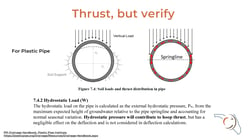
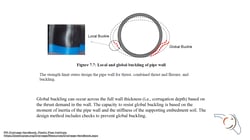
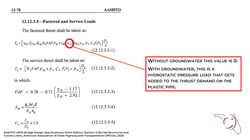
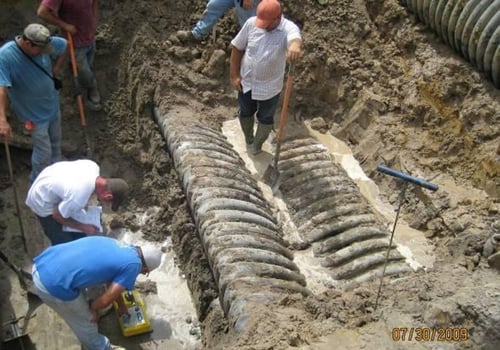
East Texas Fish Hatchery Case Study
Jasper, Texas. In 2009, a major collapse of HDPE pipe occurred at the East Texas Fish Hatchery. This failure ultimately led to a $3.3M settlement by the engineering firm. According to a forensic design assessment and failure analysis, groundwater above the springline was one of five causes, of which were not controlled during the design process.
Impact on Concrete Pipe - Concrete pipe actually benefits from the increased lateral force of the hydrostatic pressure. The reason for this is illustrated in the below graphics (click to download). Lateral pressures from embedment support and hydrostatic pressure generate bending moments in the concrete pipe wall that are opposite in direction to the moments from vertical loads. A mathematical example is provided to illustrate this point; notice the bending moment term for saturated soils is less than the term for dry soils for concrete pipe.
In addition to increased lateral pressure, groundwater reduces the friction between soil particles, thereby reducing the soil stiffness. As plastic pipe deflects under vertical load, the outward movement of the sides of the pipe mobilize the passive resistance pressure of the enveloping soil. Reducing the soil stiffness impacts the ability to provide the necessary resistance on the plastic pipe.
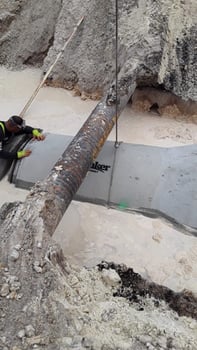
Construction Challenges
In Florida, it is difficult, and sometimes impractical, to dewater the trench. The FDOT Standard Specifications for Road and Bridge Construction (SSRBC) Section 125 -8.3.4 provides specifications for Backfill Under Wet Conditions. The Department will permit the use of coarse aggregate below the elevation at which mechanical tampers would be effective. Use coarse aggregate as specified in Section 901 for Aggregate Size Number 89, 8, 78, 7, 68, 6, or 57. Place the coarse aggregate such that it will be stable and firm. Fully wrap the aggregate with a layer of Type D-4 filter fabric, as specified in Section 985. The use of the geotextile is important in order to mitigate the migration of finer soils into the voids of the coarser graded aggregate. Contractors and CEIs refer to this as "wrapping the burrito" or as Pasco County likes to say, "making the chimichanga."
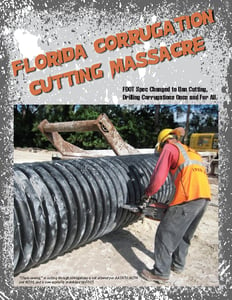 In the presence of water in the trench, lightweight pipes can float. These pipes can even float during conventional embedment compaction or during placement of flowable fill. In order to hastily "sink" a thermoplastic pipe in an inundated trench, pipe corrugations are sometimes drilled or cut in order to flood them with water. This practice of manipulating the corrugations is not authorized by AASHTO M294, M330, nor FDOT standards, regardless if it is done by the contractor or manufacturer.
In the presence of water in the trench, lightweight pipes can float. These pipes can even float during conventional embedment compaction or during placement of flowable fill. In order to hastily "sink" a thermoplastic pipe in an inundated trench, pipe corrugations are sometimes drilled or cut in order to flood them with water. This practice of manipulating the corrugations is not authorized by AASHTO M294, M330, nor FDOT standards, regardless if it is done by the contractor or manufacturer.
Please note that the FDOT has prohibited this practice in SSRBC Section 430-4 in 2019. Please note that perforated pipe (French drains) involves perforations in the valleys, not corrugation crests. Damaging the corrugation impacts the pipe's ability to resist the thrust demand and, potentially, buckling.
Joint Performance Considerations
Lastly, some parting considerations for getting a proper joint seal:
- Stable Foundation / No Differential Settlement
- Avoid Damage to Gasket Sealing Surfaces (Bell / Spigot)
- Proper Gasket Seating and Preparation
- Gasket Compression / Sufficient Homing
- Limit Deformation to <5% Diameter
Thank you, and we hope that you enjoyed this blog. Please reach out to the FCPA if you would like help with advice or specifications to manage groundwater impacts on your storm drainage system.



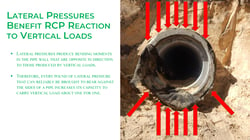
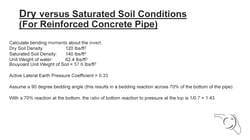
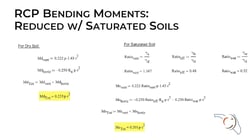
COMMENTS